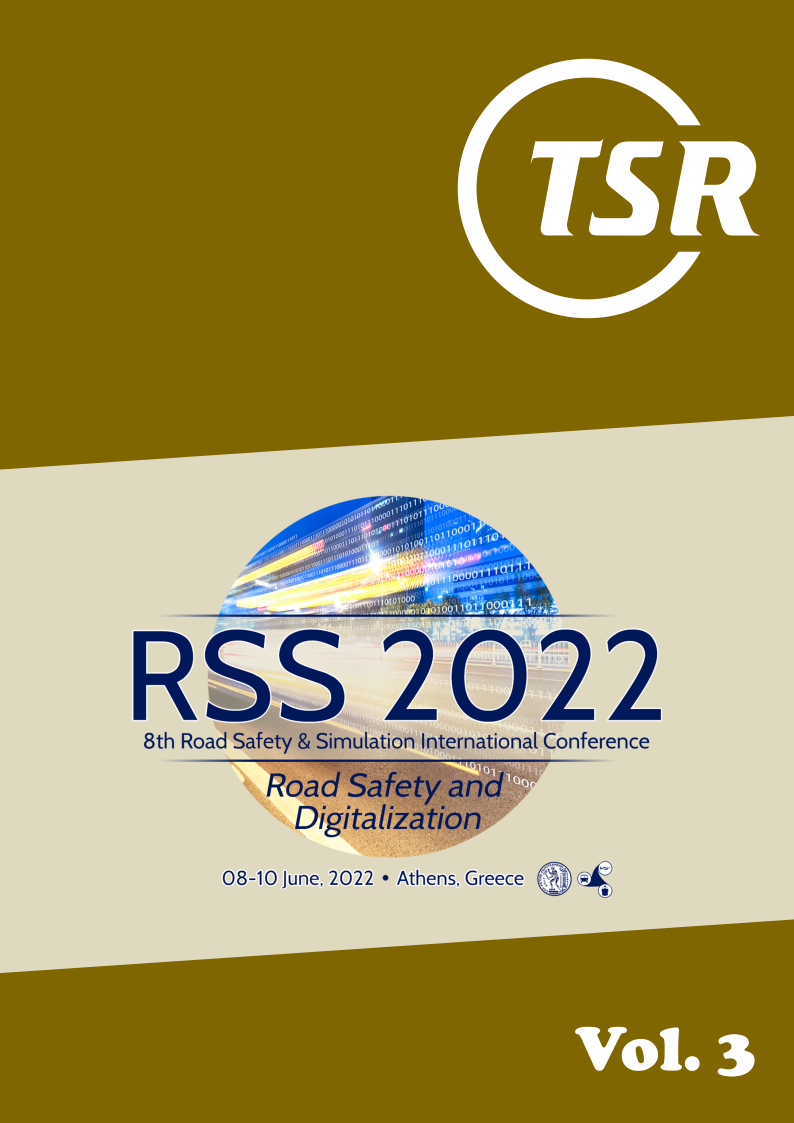Investigating pedestrian safety-related behavior in developing countries: Egypt as a case study
DOI:
https://doi.org/10.55329/htwx5986Keywords:
exploratory factory analysis (EFA), Pedestrians Behavior Scale (PBS), regression analysisAbstract
Understanding pedestrian behavior and road safety culture is essential for improving traffic safety in developing countries. The primary aim of this study was to investigate the validity for applying the Pedestrian Behavior Scale (PBS) in Egypt to explore the pedestrian behaviors in developing countries and to investigate the relationship of these behaviors across demographic variables. A Pedestrian Behavior Questionnaire (PBQ) was conducted in Egypt containing behavioral items and demographic questions with a total of 567 participants. Exploratory factor analysis (EFA) was applied to assess the number of behavioral factors that express the pedestrian behaviors. The analysis showed that the Egyptian pedestrian behaviors consist of four factors, including transgressions (violations and errors), lapses, aggressive behaviors, and positive behaviors. T-test and ANOVA were conducted to explore the significant difference across gender, age groups and education level. Furthermore, linear regression analysis was conducted to investigate how the examined variables influence the behavioral factors. The current study showed that the Pedestrian Behavior Scale (PBS) is an effective tool for investigating Egyptian pedestrian’s behaviors. This study added a validation for applying the PBS to explore the pedestrian behaviors in developing countries such as Egypt and to understand the variables affecting the pedestrian behaviors. The findings can be used by infrastructure agencies to enhance educational road safety programs and enact appropriate laws, which could reduce the number of pedestrian-related crashes.
Downloads
References
Alhajyaseen, W. K. M., M. Iryo-Asano (2017), ‘Studying critical pedestrian behavioral changes for the safety assessment at signalized crosswalks’, Safety Science, 91, 351–360, https://doi.org/10.1016/j.ssci.2016.09.002.
Antić, B., D. Pešić, N. Milutinović, M. Maslać (2016), ‘Pedestrian behaviours: Validation of the Serbian version of the pedestrian behaviour scale’, Transportation Research Part F: Traffic Psychology and Behaviour, 41, 170–178, https://doi.org/10.1016/j.trf.2016.02.004.
Bartlett, J. E., J. W. Kotrlik, C. C. Higgins (2001), ‘Organizational research: Determining appropriate sample size in survey research ’, Information technology, learning, and performance journal, 19 (1), 43–50.
Brosseau, M., S. Zangenehpour, N. Saunier, L. Miranda-Moreno (2013), ‘The impact of waiting time and other factors on dangerous pedestrian crossings and violations at signalized intersections: A case study in Montreal’, Transportation Research Part F: Traffic Psychology and Behaviour, 21, 159–172, https://doi.org/10.1016/j.trf.2013.09.010.
CAPMAS (2019), ‘Car and Train accidents report’ (Cairo, Egypt: Central Agency for Public Mobilization and Statistics), https://www.capmas.gov.eg/Admin/News/PressRelease/2019123112243_%D8%A8%D9%8A%D8%A7%D9%86%20%D8%B5%D8%AD%D9%81%D9%89%20%D8%A7%D9%86%D8%AC%D9%84%D9%8A%D8%B2%D9%89.pdf, accessed 04 October 2022.
Deb, S., L. Strawderman, J. DuBien, et al. (2017), ‘Evaluating pedestrian behavior at crosswalks: Validation of a pedestrian behavior questionnaire for the U.S. population’, Accident Analysis & Prevention, 106, 191–201, https://doi.org/10.1016/j.aap.2017.05.020.
Deb, S., L. J. Strawderman, D. W. Carruth (2018), ‘Investigating pedestrian suggestions for external features on fully autonomous vehicles: A virtual reality experiment’, Transportation Research Part F: Traffic Psychology and Behaviour, 59, 135–149, https://doi.org/10.1016/j.trf.2018.08.016.
Dinh, D. D., N. H. Vu, R. C. McIlroy, et al. (2020a), ‘Examining the roles of multidimensional fatalism on traffic safety attitudes and pedestrian behaviour’, Safety Science, 124, 104587, https://doi.org/10.1016/j.ssci.2019.104587.
Dinh, D. D., N. H. Vũ, R. C. McIlroy, et al. (2020b), ‘Effect of attitudes towards traffic safety and risk perceptions on pedestrian behaviours in Vietnam’, IATSS Research, 44 (3), 238–247, https://doi.org/10.1016/j.iatssr.2020.01.002.
Dixon, L. B. (1996), ‘Bicycle and Pedestrian Level-of-Service Performance Measures and Standards for Congestion Management Systems’, Transportation Research Record: Journal of the Transportation Research Board, 1538 (1), 1–9, https://doi.org/10.1177/0361198196153800101.
Elliott, M. A., C. J. Baughan (2004), ‘Developing a self-report method for investigating adolescent road user behaviour’, Transportation Research Part F: Traffic Psychology and Behaviour, 7 (6), 373–393, https://doi.org/10.1016/j.trf.2004.10.002.
Esmaili, A., K. Aghabayk, N. Parishad, A. N. Stephens (2021), ‘Investigating the interaction between pedestrian behaviors and crashes through validation of a pedestrian behavior questionnaire (PBQ)’, Accident Analysis & Prevention, 153, 106050, https://doi.org/10.1016/j.aap.2021.106050.
Gallin, N. (2001), ‘Quantifying pedestrian friendliness--guidelines for assessing pedestrian level of service’, Transportation Research Record: Journal of the Transportation Research Board, 10 (1), 47–55.
Granié, M.-A. (2008), ‘Influence de l’adhésion aux stéréotypes de sexe sur la perception des comportements piétons chez l’adulte’ [Influence of adherence to gender stereotypes on the perception of pedestrian behavior in adults], Recherche Transports Sécurité, 28 (101), 253–263, https://doi.org/10.3166/rts.101.253-263.
Granié, M.-A., M. Pannetier, L. Guého (2013), ‘Developing a self-reporting method to measure pedestrian behaviors at all ages’, Accident Analysis & Prevention, 50, 830–839, https://doi.org/10.1016/j.aap.2012.07.009.
van Griethuijsen, R. A. L. F., M. W. van Eijck, H. Haste, et al. (2014), ‘Global Patterns in Students' Views of Science and Interest in Science’, Research in Science Education, 45 (4), 581–603, https://doi.org/10.1007/s11165-014-9438-6.
Gårder, P. E. (2004), ‘The impact of speed and other variables on pedestrian safety in Maine’, Accident Analysis & Prevention, 36 (4), 533–542, https://doi.org/10.1016/s0001-4575(03)00059-9.
Hair, J. F., W. C. Black, B. J. Babin, et al. (2009), Multivariate data analysis (Upper Saddle River, NJ, USA: Pearson Education) 7th Edition.
Hair, J. F., W. C. Black, B. J. Babin, et al. (2014), Multivariate data analysis (Upper Saddle River, NJ, USA: Pearson Education) Pearson New International Edition.
Hamann, C., D. Dulf, E. Baragan-Andrada, et al. (2017), ‘Contributors to pedestrian distraction and risky behaviours during road crossings in Romania’, Injury Prevention, 23 (6), 370–376, https://doi.org/10.1136/injuryprev-2016-042219.
Hezaveh, A. M., M. F. Zavareh, C. R. Cherry, T. Nordfjærn (2018), ‘Errors and violations in relation to bicyclists’ crash risks: Development of the Bicycle Rider Behavior Questionnaire (BRBQ)’, Journal of Transport & Health, 8, 289–298, https://doi.org/10.1016/j.jth.2017.11.003.
Hőgye-Nagy, Á. (2018), ‘A Gyalogos Viselkedés Skála Magyar Nyelvű Adaptációja’ [Adaptation of the Pedestrian Behavior Scale in Hungarian], Alkalmazott Pszichológia 18 (4), 59–76, http://ap.elte.hu/wp-content/uploads/2019/01/AP_2018_4_Hogye-Nagy.pdf, accessed 04 October 2022.
Jalilian, M., F. Darani , B. Mahaki, et al. (2015), ‘Pedestrian safety in traffic environment: An E-mail-based intervention to promote crossing behaviors among medical college students’, International Journal of Environmental Health Engineering, 4 (1), 38, https://www.ijehe.org/text.asp?2015/4/1/38/170705, accessed 4 October 2022.
Koh, P. P., Y. D. Wong, P. Chandrasekar (2014), ‘Safety evaluation of pedestrian behaviour and violations at signalised pedestrian crossings’, Safety Science, 70, 143–152, https://doi.org/10.1016/j.ssci.2014.05.010.
Lawton, R., D. Parker, A. S. R. Manstead, S. G. Stradling (1997), ‘The Role of Affect in Predicting Social Behaviors: The Case of Road Traffic Violations’, Journal of Applied Social Psychology, 27 (14), 1258–1276, https://doi.org/10.1111/j.1559-1816.1997.tb01805.x.
Lee, C., M. Abdel-Aty (2005), ‘Comprehensive analysis of vehicle–pedestrian crashes at intersections in Florida’, Accident Analysis & Prevention, 37 (4), 775–786, https://doi.org/10.1016/j.aap.2005.03.019.
Liu, M., J. Wu, A. Yousaf, et al. (2021), ‘Exploring the Relationship between Attitudes, Risk Perceptions, Fatalistic Beliefs, and Pedestrian Behaviors in China’, International Journal of Environmental Research and Public Health, 18 (7), 3378, https://doi.org/10.3390/ijerph18073378.
McIlroy, R. C., K. L. Plant, U. Jikyong, et al. (2019), ‘Vulnerable road users in low-, middle-, and high-income countries: Validation of a Pedestrian Behaviour Questionnaire’, Accident Analysis & Prevention, 131, 80–94, https://doi.org/10.1016/j.aap.2019.05.027.
McIlroy, R. C., G. O. Kokwaro, J. Wu, et al. (2020a), ‘How do fatalistic beliefs affect the attitudes and pedestrian behaviours of road users in different countries? A cross-cultural study’, Accident Analysis & Prevention, 139, 105491, https://doi.org/10.1016/j.aap.2020.105491.
McIlroy, R. C., V. H. Nam, B. W. Bunyasi, et al. (2020b), ‘Exploring the relationships between pedestrian behaviours and traffic safety attitudes in six countries’, Transportation Research Part F: Traffic Psychology and Behaviour, 68, 257–271, https://doi.org/10.1016/j.trf.2019.11.006.
Moyano Dı́az, E. (1997), ‘Teoría del Comportamiento Planificado e intención de infringir normas de transito en peatones’ [Theory of planned behavior and pedestrians' intention to violate transit rules], Estudos de Psicologia, 2 (2), 335–348, http://pepsic.bvsalud.org/scielo.php?script=sci_arttext&pid=S1413-294X1997000200008&lng=pt&nrm=i&tlng=es, accessed 6 October 2022.
Nordfjærn, T., Ö. Şimşekoğlu (2013), ‘The role of cultural factors and attitudes for pedestrian behaviour in an urban Turkish sample’, Transportation Research Part F: Traffic Psychology and Behaviour, 21, 181–193, https://doi.org/10.1016/j.trf.2013.09.015.
Nordfjærn, T., M. F. Zavareh (2016), ‘Individualism, collectivism and pedestrian safety: A comparative study of young adults from Iran and Pakistan’, Safety Science, 87, 8–17, https://doi.org/10.1016/j.ssci.2016.03.005.
Nunnally, J. (1978), Psychometric Methods (New York, USA: McGraw Hill) 2nd Edition.
O'Hern, S., A. N. Stephens, N. Estgfaeller, et al. (2020), ‘Self-reported pedestrian behaviour in Australia’, Transportation Research Part F: Traffic Psychology and Behaviour, 75, 134–144, https://doi.org/10.1016/j.trf.2020.10.002.
O’connor, B. P. (2000), ‘SPSS and SAS programs for determining the number of components using parallel analysis and Velicer’s MAP test’, Behavior Research Methods, Instruments, & Computers, 32 (3), 396–402, https://doi.org/10.3758/bf03200807.
Papadimitriou, E. (2012), ‘Theory and models of pedestrian crossing behaviour along urban trips’, Transportation Research Part F: Traffic Psychology and Behaviour, 15 (1), 75–94, https://doi.org/10.1016/j.trf.2011.11.007.
Papadimitriou, E., S. Lassarre, G. Yannis (2016), ‘Introducing human factors in pedestrian crossing behaviour models’, Transportation Research Part F: Traffic Psychology and Behaviour, 36, 69–82, https://doi.org/10.1016/j.trf.2015.11.003.
Pulugurtha, S. S., V. K. Krishnakumar, S. S. Nambisan (2007), ‘New methods to identify and rank high pedestrian crash zones: An illustration’, Accident Analysis & Prevention, 39 (4), 800–811, https://doi.org/10.1016/j.aap.2006.12.001.
Qu, W., H. Zhang, W. Zhao, et al. (2016), ‘The effect of cognitive errors, mindfulness and personality traits on pedestrian behavior in a Chinese sample’, Transportation Research Part F: Traffic Psychology and Behaviour, 41, 29–37, https://doi.org/10.1016/j.trf.2016.06.009.
Quistberg, D. A., E. J. Howard, P. M. Hurvitz, et al. (2017), ‘The Relationship Between Objectively Measured Walking and Risk of Pedestrian-Motor Vehicle Collision’, American Journal of Epidemiology, 185 (9), 810–821, https://doi.org/10.1093/aje/kwx020.
Reason, J., A. Manstead, S. Stradling, et al. (1990), ‘Errors and violations on the roads: a real distinction?’, Ergonomics, 33 (10–11), 1315–1332, https://doi.org/10.1080/00140139008925335.
Robertson, O., M. S. Evans (2020), ‘Just how reliable is your internal reliability? An overview of Cronbach’s alpha’, PsyPAG Quartely, 115, 23–26, https://shop.bps.org.uk/psypag-quarterly-%E2%80%93-issue-115-june-2020, accessed 4 October 2022.
Ruiz, J. A., D. A. González-García, K. A. Bermúdez-Rivera (2019), ‘Validación del Brief Pedestrian Behavior Questionnaire en una muestra de estudiantes mexicanos’ [Validation of the Brief Pedestrian Behavior Questionnaire in a sample of Mexican students], Psicología y Salud, 30 (1), 105–115, https://doi.org/10.25009/pys.v30i1.2622.
Sarkar, S. (1995), ‘Evaluation of safety for pedestrians at macro-and microlevels in urban areas’, Transportation Research Record: Journal of the Transportation Research Board, 1502, 105–118.
Simon, F., C. Corbett (1996), ‘Road traffic offending, stress, age, and accident history among male and female drivers’, Ergonomics, 39 (5), 757–780, https://doi.org/10.1080/00140139608964497.
Şimşekoğlu, Ö. (2014), ‘How Do Attitudes, Personality Traits, and Driver Behaviors Relate to Pedestrian Behaviors? A Turkish Case’, Traffic Injury Prevention, 16 (1), 84–89, https://doi.org/10.1080/15389588.2014.880785.
Solmazer, G., D. Azık, G. Fındık, et al. (2020), ‘Cross-cultural differences in pedestrian behaviors in relation to values: A comparison of five countries’, Accident Analysis & Prevention, 138, 105459, https://doi.org/10.1016/j.aap.2020.105459.
Sze, N. N., S. C. Wong (2007), ‘Diagnostic analysis of the logistic model for pedestrian injury severity in traffic crashes’, Accident Analysis & Prevention, 39 (6), 1267–1278, https://doi.org/10.1016/j.aap.2007.03.017.
Taber, K. S. (2017), ‘The Use of Cronbach’s Alpha When Developing and Reporting Research Instruments in Science Education’, Research in Science Education, 48 (6), 1273–1296, https://doi.org/10.1007/s11165-016-9602-2.
Tavakol, M., R. Dennick (2011), ‘Making sense of Cronbach’s alpha’, International Journal of Medical Education, 2, 53–59, https://doi.org/10.5116/ijme.4dfb.8dfd.
Tay, R., S. M. Rifaat, H. C. Chin (2008), ‘A logistic model of the effects of roadway, environmental, vehicle, crash and driver characteristics on hit-and-run crashes’, Accident Analysis & Prevention, 40 (4), 1330–1336, https://doi.org/10.1016/j.aap.2008.02.003.
Useche, S. A., L. Montoro, J. M. Tomas, B. Cendales (2018), ‘Validation of the Cycling Behavior Questionnaire: A tool for measuring cyclists' road behaviors’, Transportation Research Part F: Traffic Psychology and Behaviour, 58, 1021–1030, https://doi.org/10.1016/j.trf.2018.08.003.
WHO (2018), ‘Global status report on road safety 2018’ (World Health Organization), https://www.who.int/publications/i/item/9789241565684, accessed 04 October 2022.
Yıldırım, Z. (2007), ‘Religiousness, conservatism and their relationship with traffic behaviours’, Master thesis, Middle East Technical University, Department of Psychology, https://citeseerx.ist.psu.edu/viewdoc/download?doi=10.1.1.633.8093&rep=rep1&type=pdf, accessed 04 October 2022.
Özkan, T., T. Lajunen (2005), ‘A new addition to DBQ: Positive Driver Behaviours Scale’, Transportation Research Part F: Traffic Psychology and Behaviour, 8 (4–5), 355–368, https://doi.org/10.1016/j.trf.2005.04.018.
Downloads
Published
How to Cite
Issue
Section
Categories
License
Copyright (c) 2022 Abduallah Bayomi, Mohamed Shawky, Mohamed Okail, Ahmed Osama

This work is licensed under a Creative Commons Attribution 4.0 International License.











